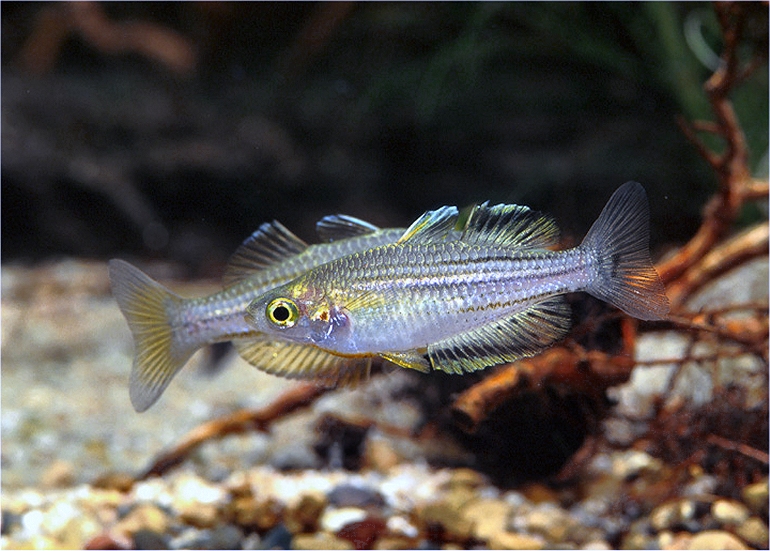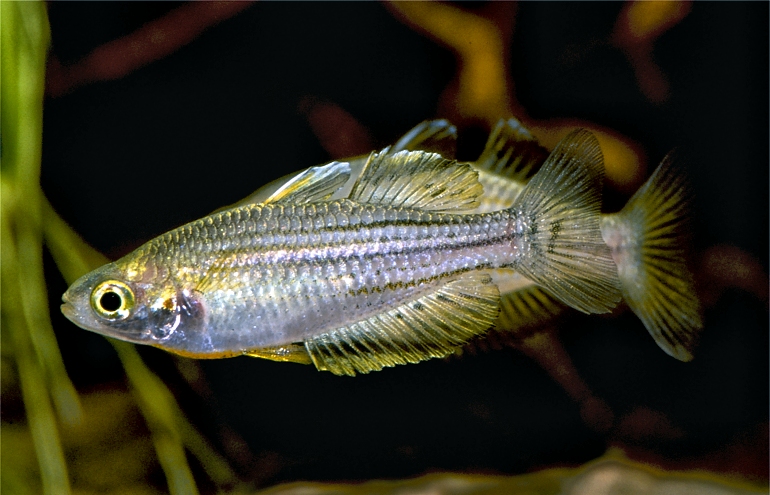|
 |
Melanotaenia wilsoni - photo© Gunther Schmida |
Hammer et al., 2019
Little Rainbowfish
Species Summary
Melanotaenia wilsoni is generally yellow-brownish on the upper half of the body and silvery-white on the lower half. There are seven or eight black body stripes, the middle is full and thickest with a dark purple hue, the second stripe out from the middle both dorsally and ventrally is also full and black in colour, other stripes tend to be broken and black in colour; head darker brown, lips brown sometimes with a hint of orange; small orange to red mark on the upper operculum; iris silver to orangeish; fins pale, with distinct zonation in the dorsal and anal fins formed by a thick greyish to black band that can appear to cut diagonally across the fin beginning submarginal at the anterior part of the fin, there is a corresponding thick to thin area of light yellow colour above the band with often a whitish to light blue fin margin, and inside the black band is typically an area of pale yellow to orange with a line of scattered spots or blotches close to the fin base; an area of orange can be present on the breast into the pelvic fins, brighter in males. Breeding males tend to develop an overall silvery-white body sheen and brighter white-yellow on the fins with the orange on the breast intensifying, mature females a bronze colour with intensified purple mid-lateral body stripe; otherwise sexual dimorphism is slight. A faint, rarely bright, white to yellow (sometimes pale orange) nape stripe can be 'flashed' by courting and sparring males.
Distribution & Habitat
Melanotaenia wilsoni is native to tropical northern Australia, south of Darwin in the Northern Territory. The known range is highly restricted (extent of occurrence 26 km²) being recorded in three small streams draining west off the Tabletop Range, namely Burton Creek (Finniss River system) and Tolmer and Sandy creeks (Reynolds River system). Habitat is shallow (<50 cm) comprising small Pandanus lined spring fed creeks over sandy soils with strong lateral connectivity to densely vegetated peat swamp and side-channel areas. Swamp and channel habitat can be seasonal or retract to refuge holes. Abundance of fish is typically very low, adults being found scattered along stream margins and sometimes concentrated in small permanent side pools, and juveniles in seasonally flooded areas. Water transparency ranges from clear (streams) to heavily stained, with indicative water quality parameters in the dry season including pH 6.0-6.5, temperature 23-24°C, water conductivity 15-30 µS with general hardness and carbonate hardness <10 ppm. Co-occurs with M. nigrans and other swamp dwelling fish including Pseudomugil gertrudae. Melanotaenia wilsoni is the smallest growing of all known species in the genus. Little else is known on the biology of the species other than records of spawning and behaviour in captivity.
 |
Melanotaenia wilsoni - photo© Gunther Schmida |
Etymology
This species was named for David Wilson who was the first person to document the presence of the small isolated population in the Northern Territory, and has worked tirelessly and generously to promote the sustainable use and conservation of native aquatic animals, especially rainbowfishes.
Literature
Hammer M.P., G.R. Allen, K.C. Martin, M. Adams and P.J. Unmack (2019) Two new species of dwarf rainbowfishes (Atheriniformes: Melanotaeniidae) from northern Australia and southern New Guinea. Zootaxa 4701 (3): 201-234.
Adrian R. Tappin
December, 2019



|
|

